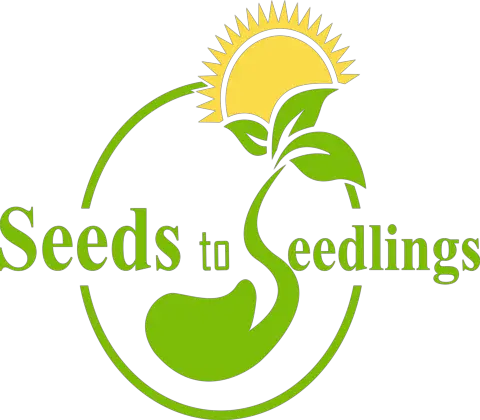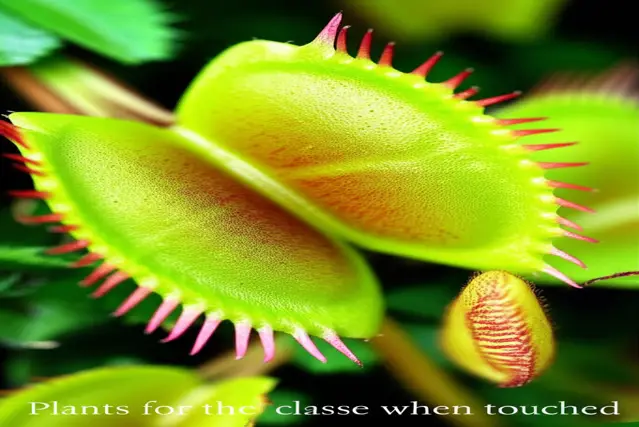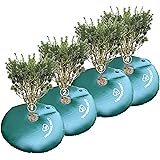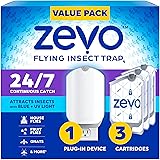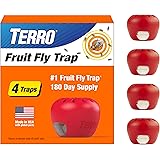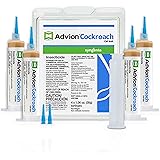Have you ever witnessed a plant seemingly recoil from your touch? It’s a fascinating phenomenon, and some plants have mastered the art of rapid movement as a defense mechanism or to aid in capturing prey. These sensitive plants are a source of endless fascination for gardeners, botanists, and curious minds alike.
In this comprehensive guide, we’ll explore five of the most intriguing plants that close when touched, diving into their unique adaptations, care requirements, and fun facts. Get ready to delve into the world of thigmotropism and nastic movements!
Introduction: The Wonderful World of Sensitive Plants
The plant kingdom is full of surprises, and the ability to move rapidly is one of the most captivating. While most plants exhibit slow, gradual movements (like turning towards the sun), some have evolved the ability to respond almost instantly to external stimuli, especially touch.
This sensitivity is not magic; it’s a complex interplay of cellular mechanisms, water pressure changes, and electrical signals. These “sensitive plants” demonstrate the incredible adaptability and diversity found in nature.
This blog post will cover:
- Understanding the science behind plant movement.
- Detailed profiles of five key plants that close when touched.
- Care tips for successfully growing these plants.
- Current trends and regulations related to owning and cultivating these species.
- Answers to frequently asked questions about sensitive plants.
Understanding Plant Movement: Thigmotropism and Nastic Movements
Before we dive into specific plant species, let’s understand the underlying mechanisms that allow plants to move so quickly. Two primary concepts are crucial: thigmotropism and nastic movements.
Thigmotropism: Growth in Response to Touch
Thigmotropism is a directional growth response to touch or physical contact. This type of movement is generally slow and involves changes in growth patterns over time. Think of a vine tendril wrapping around a support – that’s thigmotropism in action.
The cells on the side of the tendril that touches the support grow slower than the cells on the opposite side, causing the tendril to curve and grip.

sensitive plant
Nastic Movements: Rapid, Reversible Reactions
Nastic movements, on the other hand, are rapid, reversible, and non-directional responses to stimuli. The direction of the stimulus does *not* determine the direction of the movement. The closing of the Mimosa pudica’s leaves when touched is a prime example of a nastic movement called seismonastic movement (or thigmonastic movement). These movements are often driven by changes in turgor pressure (water pressure within cells).
Read More: Best Plants for Attracting Hummingbirds
Turgor Pressure: The Key to Rapid Movement
Turgor pressure is essential for plant rigidity. When cells are full of water, they exert pressure against their cell walls, keeping the plant upright and firm. In sensitive plants, specialized cells called pulvini are located at the base of leaves or leaflets. These pulvini are responsible for the rapid changes in turgor pressure that cause the plant to close. When stimulated, ions (like potassium and chloride) are rapidly pumped out of the cells in the pulvinus.
Water follows the ions due to osmosis, causing the cells to lose turgor pressure and shrink. This shrinkage causes the leaves or leaflets to fold or droop.
Electrical Signals: A Plant’s Nervous System?
While plants don’t have a nervous system like animals, they *do* use electrical signals to transmit information. When a sensitive plant is touched, an electrical signal travels through the plant’s tissues to the pulvini, triggering the ion and water movement described above.
These electrical signals are analogous to nerve impulses, allowing for rapid communication throughout the plant. The speed of these signals can vary depending on the plant species and environmental conditions.
Five Fascinating Plants That Close When Touched
Now, let’s explore five captivating plants that exhibit the fascinating ability to close when touched.
1. Mimosa pudica: The Sensitive Plant (or Touch-Me-Not)
Mimosa pudica, also known as the sensitive plant, humble plant, or touch-me-not, is perhaps the most well-known example of a plant that closes when touched. This fascinating plant belongs to the Fabaceae (legume) family and is native to South and Central America but has naturalized in many tropical and subtropical regions worldwide.
Appearance and Characteristics
Mimosa pudica is a low-growing, sprawling plant with delicate, feathery leaves composed of numerous small leaflets. The plant typically grows to a height of 1 to 3 feet. Its stems are often prickly, providing an additional layer of defense. It produces small, pink, pom-pom-like flowers that are attractive to pollinators.
The Mechanism Behind the Movement
When touched, shaken, warmed, or even rapidly cooled, the leaflets of Mimosa pudica quickly fold inward, and the entire leaf droops downward. This rapid movement is a defensive mechanism, thought to startle potential herbivores and make the plant appear less appealing as food.
The movement is driven by the pulvini located at the base of each leaflet and leaf. As described earlier, the pulvini rapidly lose turgor pressure due to the movement of ions and water, causing the leaves to collapse. The plant typically recovers within a few minutes to an hour, depending on the intensity of the stimulus.
Cultivation and Care
Mimosa pudica is relatively easy to grow from seed and can be grown as an annual in cooler climates or as a perennial in warmer regions (USDA zones 9-11). Here are some key care tips:
- Light: Requires bright, indirect sunlight. A south-facing window is ideal.
- Soil: Well-draining soil is essential. A mix of potting soil, perlite, and vermiculite works well.
- Watering: Keep the soil consistently moist but not waterlogged. Allow the top inch of soil to dry out between waterings.
- Temperature: Prefers warm temperatures between 65°F and 80°F (18°C and 27°C).
- Humidity: Thrives in moderate humidity.
- Fertilizing: Feed with a balanced liquid fertilizer every 2-4 weeks during the growing season (spring and summer).
Fun Facts and Interesting Information
- The name “pudica” comes from the Latin word for “shy” or “bashful,” referring to the plant’s sensitive nature.
- Mimosa pudica is used in traditional medicine in some cultures to treat various ailments, including insomnia and wound healing. However, consult a medical professional before using any plant for medicinal purposes.
- The plant’s roots can fix nitrogen in the soil, similar to other legumes, making it a beneficial plant for soil health.
Current Trends and Regulations
Mimosa pudica is readily available for purchase as seeds or small plants from nurseries and online retailers. There are generally no specific regulations restricting its cultivation, except in areas where it is considered an invasive species. Always check with your local agricultural extension office to ensure that growing Mimosa pudica is permitted in your area.
Current trends include using *Mimosa pudica* as a novelty plant in educational settings and as a conversation starter in homes. Its unique sensitivity makes it a popular choice for demonstrating plant behavior in classrooms.
2. Dionaea muscipula: The Venus Flytrap
Dionaea muscipula, commonly known as the Venus flytrap, is a carnivorous plant famous for its snap traps that capture insects. It’s native to the wetlands of North and South Carolina in the United States.
Appearance and Characteristics
The Venus flytrap is a small plant with rosettes of leaves that grow close to the ground. Each leaf ends in a modified trap consisting of two hinged lobes fringed with stiff, interlocking bristles called cilia. On the inner surface of each lobe are three to five trigger hairs (also called sensitive hairs).
The Mechanism Behind the Movement
When an insect touches two trigger hairs within a short period (typically within 20 seconds), the trap rapidly snaps shut, trapping the insect inside. The speed of the closure is remarkable, taking only about 0.1 seconds to complete. The trap then seals tightly, preventing the insect from escaping.
The snap is triggered by an electrical signal generated by the trigger hairs. This signal causes a rapid change in turgor pressure in the cells of the trap lobes, leading to their sudden closure. The plant then secretes digestive enzymes to break down the insect and absorb its nutrients.
Cultivation and Care
Venus flytraps can be challenging to grow, but with the right conditions, they can thrive. Here are some essential care tips:
- Light: Requires at least 6 hours of direct sunlight per day.
- Soil: Must be grown in nutrient-poor, acidic soil. A mix of sphagnum peat moss and perlite (1:1 ratio) is ideal. *Never* use regular potting soil or fertilized soil.
- Watering: Use only distilled water, rainwater, or reverse osmosis water. Tap water contains minerals that can harm the plant. Keep the soil consistently moist but not waterlogged. Water from the bottom by placing the pot in a tray of water.
- Temperature: Prefers warm temperatures during the growing season (spring and summer) and a period of dormancy during the winter months with cooler temperatures (40°F to 50°F).
- Humidity: Thrives in high humidity (50% or higher).
- Feeding: Venus flytraps can capture insects on their own. If grown indoors, you can supplement their diet by feeding them small insects (such as flies or small ants) every few weeks. Only feed one trap at a time.
Fun Facts and Interesting Information
- The Venus flytrap is one of the few carnivorous plants that exhibit rapid movement.
- The plant can only close its trap a limited number of times (typically 3-5 times) before it dies.
- Venus flytraps are native to a very small area in the Carolinas, making them vulnerable to habitat loss and poaching.
Current Trends and Regulations
Venus flytraps are popular novelty plants and are often sold in nurseries and garden centers. However, due to their vulnerability in the wild, there are regulations in place to protect them. In North Carolina, it is illegal to collect Venus flytraps from the wild without a permit. The IUCN (International Union for Conservation of Nature) lists the Venus flytrap as Vulnerable.
Current trends include the development of tissue-cultured Venus flytraps to reduce the demand for wild-collected plants. Additionally, there’s increasing awareness of the need to protect their natural habitat.
Consider buying only from reputable sellers who source their plants responsibly. Look for plants that are labeled as “tissue-cultured” or “nursery-grown” to ensure that you are not contributing to the depletion of wild populations. Always check local and state regulations regarding the purchase and ownership of Venus flytraps.
3. Codariocalyx motorius: The Telegraph Plant (or Semaphore Plant)
Codariocalyx motorius, commonly known as the telegraph plant or semaphore plant, is a fascinating plant known for its rapid leaf movements that resemble semaphore signals. It belongs to the Fabaceae (legume) family and is native to tropical Asia.
Appearance and Characteristics
The telegraph plant is a shrubby perennial that can grow up to 3-6 feet tall. It has three-part leaves: a large central leaflet and two smaller lateral leaflets located at the base of the central leaflet. It produces small, purple flowers in clusters.
The Mechanism Behind the Movement
The telegraph plant is unique because its lateral leaflets exhibit rapid, jerky movements throughout the day, even without being touched. These movements are thermonastic, meaning they are influenced by temperature. The lateral leaflets rotate on their axes, moving up and down in a manner that resembles semaphore signals.
The movements are driven by changes in turgor pressure in specialized cells within the pulvini located at the base of the lateral leaflets. The plant uses these movements to maximize sunlight capture and regulate its internal temperature.
Cultivation and Care
The telegraph plant can be a bit challenging to grow, but with the right conditions, it can thrive. Here are some essential care tips:
- Light: Requires bright, indirect sunlight. A south-facing window is ideal.
- Soil: Well-draining soil is essential. A mix of potting soil, perlite, and vermiculite works well.
- Watering: Keep the soil consistently moist but not waterlogged. Allow the top inch of soil to dry out between waterings.
- Temperature: Prefers warm temperatures between 65°F and 80°F (18°C and 27°C).
- Humidity: Thrives in moderate to high humidity.
- Fertilizing: Feed with a balanced liquid fertilizer every 2-4 weeks during the growing season (spring and summer).
Fun Facts and Interesting Information
- The telegraph plant’s movements inspired Charles Darwin, who studied and wrote about its unique behavior in his book “The Power of Movement in Plants.”
- The plant’s movements are most pronounced when the temperature is warm and the plant is exposed to sunlight.
- The telegraph plant is used in traditional medicine in some cultures to treat various ailments. However, consult a medical professional before using any plant for medicinal purposes.
Current Trends and Regulations
The telegraph plant is less common than Mimosa pudica and Venus flytraps but can be found at specialty nurseries and online retailers. There are generally no specific regulations restricting its cultivation.
Current trends include using the telegraph plant as an educational tool to demonstrate plant movement and as a novelty plant in homes and gardens. Its unique movements make it a captivating addition to any plant collection.
4. Neptunia oleracea: Water Mimosa
Neptunia oleracea, also known as water mimosa or sensitive jointvetch, is an aquatic plant with similar leaf-folding behavior to Mimosa pudica. It belongs to the Fabaceae family and is native to tropical and subtropical regions of Asia.
Appearance and Characteristics
Neptunia oleracea is a floating or creeping aquatic plant with feathery, compound leaves that resemble those of Mimosa pudica. It produces yellow, pom-pom-like flowers that are similar in appearance to Mimosa flowers but yellow. The plant is known for its spongy, inflated stems that help it float on water.
The Mechanism Behind the Movement
Like Mimosa pudica, the leaflets of Neptunia oleracea fold inward when touched, shaken, or exposed to changes in temperature. This movement is also driven by changes in turgor pressure in the pulvini located at the base of each leaflet and leaf.
Cultivation and Care
Neptunia oleracea is typically grown in aquatic gardens or ponds. Here are some essential care tips:
- Light: Requires full sun to partial shade.
- Water: Must be grown in water. Keep the water level consistent.
- Soil: Not applicable, as it’s grown in water. However, providing a nutrient-rich substrate at the bottom of the pond or container can benefit the plant.
- Temperature: Prefers warm temperatures.
- Fertilizing: Can be fertilized with a liquid aquatic plant fertilizer every few weeks during the growing season.
Fun Facts and Interesting Information
- Neptunia oleracea is edible and is commonly used as a vegetable in Southeast Asian cuisine.
- The plant’s spongy stems help it float and provide buoyancy in the water.
- Neptunia oleracea can help improve water quality by absorbing nutrients and providing habitat for aquatic organisms.
Current Trends and Regulations
Neptunia oleracea is sometimes available at aquatic plant nurseries and online retailers. In some regions, it is considered an invasive species, so it’s essential to check local regulations before planting it in outdoor water bodies. It’s very important to make sure that this plant does not escape into natural waterways where it could harm the local ecosystems.
Current trends include using Neptunia oleracea as a functional and ornamental plant in aquatic gardens. Its edible leaves and water-purifying properties make it a valuable addition to aquaponics systems and permaculture designs.
5. Biophytum sensitivum: Little Tree Plant
Biophytum sensitivum, often called the little tree plant or sensitive plant, is a small, palm-like plant known for its touch-sensitive leaves. It belongs to the Oxalidaceae family.
Appearance and Characteristics
This plant is unique in its appearance, resembling a miniature palm tree. It typically grows to a height of 6-12 inches. It has a single stem topped with a crown of compound leaves that radiate outwards. The leaves are composed of numerous small leaflets.
The Mechanism Behind the Movement
When touched, the leaflets of Biophytum sensitivum fold downwards rapidly, similar to Mimosa pudica. The movement is a defensive mechanism to deter herbivores or reduce water loss. This action is facilitated by pulvini located at the base of each leaflet.
Cultivation and Care
Biophytum sensitivum can be grown indoors with the right care. Here are some essential care tips:
- Light: Prefers bright, indirect sunlight. Avoid direct sunlight, which can scorch the leaves.
- Soil: Requires well-draining soil that is rich in organic matter. A mix of potting soil, peat moss, and perlite is suitable.
- Watering: Keep the soil consistently moist but not waterlogged. Allow the top inch of soil to dry out between waterings.
- Temperature: Prefers warm temperatures between 65°F and 75°F (18°C and 24°C).
- Humidity: Thrives in high humidity. Consider using a humidifier or placing the plant on a pebble tray filled with water.
- Fertilizing: Feed with a diluted balanced liquid fertilizer every 2-4 weeks during the growing season (spring and summer).
Fun Facts and Interesting Information
- The plant’s palm-like appearance makes it a popular ornamental plant.
- Biophytum sensitivum is relatively easy to propagate from seeds or stem cuttings.
- The plant is believed to have medicinal properties in some traditional medicine systems.
Read More: Best Vegetables for a Rainy Ledge: For Your Space
Current Trends and Regulations
Biophytum sensitivum is gaining popularity as a houseplant due to its unique appearance and touch-sensitive leaves. It can be found at specialty nurseries and online retailers. There are generally no specific regulations restricting its cultivation.
Current trends include growing Biophytum sensitivum in terrariums or small containers to showcase its unique growth habit. It’s also used in educational settings to demonstrate plant sensitivity and movement.

mimosa pudica
Comparing the Sensitive Plants: A Quick Reference Guide
Here’s a table summarizing the key features of the five sensitive plants discussed:
| Plant Name | Common Name | Native Region | Mechanism of Movement | Light Requirements | Water Requirements | Special Care Notes |
|---|---|---|---|---|---|---|
| Mimosa pudica | Sensitive Plant, Touch-Me-Not | South and Central America | Turgor pressure changes in pulvini | Bright, indirect sunlight | Consistently moist, well-draining soil | Can be grown as an annual in cooler climates |
| Dionaea muscipula | Venus Flytrap | North and South Carolina, USA | Rapid trap closure triggered by sensitive hairs | At least 6 hours of direct sunlight | Distilled water only, keep soil moist | Requires nutrient-poor, acidic soil |
| Codariocalyx motorius | Telegraph Plant, Semaphore Plant | Tropical Asia | Thermonastic movements of lateral leaflets | Bright, indirect sunlight | Consistently moist, well-draining soil | Movements are most pronounced in warm temperatures |
| Neptunia oleracea | Water Mimosa | Tropical and subtropical Asia | Turgor pressure changes in pulvini | Full sun to partial shade | Grown in water | Edible leaves, can be invasive in some regions |
| Biophytum sensitivum | Little Tree Plant | Tropical regions | Turgor pressure changes in pulvini | Bright, indirect sunlight | Consistently moist, well-draining soil | Prefers high humidity |
Troubleshooting Common Problems
Even with the best care, you may encounter some challenges when growing sensitive plants. Here are some common problems and how to address them:
- Yellowing Leaves: Can be caused by overwatering, underwatering, nutrient deficiencies, or improper lighting. Adjust your watering schedule, check the soil pH, and ensure the plant is receiving adequate light.
- Lack of Movement: May be due to cold temperatures, low humidity, or lack of water. Ensure the plant is in a warm, humid environment and that the soil is consistently moist.
- Pest Infestations: Common pests include aphids, spider mites, and mealybugs. Treat infestations with insecticidal soap or neem oil.
- Trap Death (Venus Flytrap): Over-triggering the traps without feeding can exhaust the plant. Avoid triggering the traps unnecessarily. Only feed one trap at a time.
- Slow Growth: May be due to insufficient light, poor soil quality, or lack of nutrients. Provide adequate light, use well-draining soil, and fertilize regularly during the growing season.
Ethical Considerations: Sustainable Sourcing and Conservation
When purchasing sensitive plants, it’s essential to consider ethical and sustainable sourcing practices. Wild populations of some species, such as the Venus flytrap, are threatened by habitat loss and over-collection.
Support nurseries and suppliers that propagate their plants responsibly and avoid purchasing plants that have been collected from the wild. You can usually tell if a plant is wild caught as it will have damage on the leaves or traps, or signs of having been dug up recently.
By choosing sustainably sourced plants, you can contribute to the conservation of these fascinating species and ensure that they are available for future generations to enjoy. Always check the source before purchasing to make sure that your plant was cultivated by a responsible grower.
Incorporating Sensitive Plants into Your Garden or Home
Sensitive plants can add a unique and engaging element to your garden or home. Here are some ideas for incorporating them into your space:
- Educational Displays: Use sensitive plants in educational displays to demonstrate plant movement and adaptation.
- Terrariums: Create a terrarium featuring Biophytum sensitivum or other small sensitive plants.
- Aquatic Gardens: Incorporate Neptunia oleracea into an aquatic garden or pond.
- Novelty Gifts: Sensitive plants make unique and memorable gifts for plant lovers.
- Classroom Projects: They’re excellent for science projects because students can observe reactions and learn about plant biology.
The Future of Sensitive Plant Research
Research into the mechanisms behind plant movement is ongoing. Scientists are exploring the genetic and molecular basis of thigmotropism and nastic movements. Advanced imaging techniques are being used to study the cellular processes involved in rapid plant movements in real-time.
This research has the potential to reveal new insights into plant physiology and could lead to the development of new technologies inspired by plant movements. For example, researchers are exploring the use of plant-based sensors and actuators in robotics and engineering.
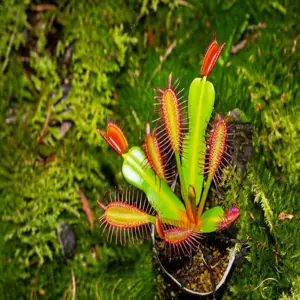
touch-me-not
FAQ: Your Questions About Sensitive Plants Answered
Here are some frequently asked questions about plants that close when touched:
What causes a sensitive plant to close its leaves?
The closing of a sensitive plant’s leaves is caused by a rapid change in turgor pressure in specialized cells called pulvini, located at the base of each leaflet and leaf. When stimulated, these cells lose water, causing the leaves to collapse.
How long does it take for a sensitive plant to reopen after closing?
The time it takes for a sensitive plant to reopen its leaves depends on the intensity of the stimulus and the plant’s overall health. Typically, it takes between a few minutes to an hour for the leaves to fully reopen.
Is it harmful to touch a sensitive plant frequently?
While touching a sensitive plant is generally not harmful, excessive or repeated touching can stress the plant and deplete its energy reserves. It’s best to avoid touching the plant unnecessarily.
Can I grow a Venus flytrap indoors?
Yes, Venus flytraps can be grown indoors, but they require specific conditions, including bright sunlight, nutrient-poor soil, and distilled water. They also need a period of dormancy during the winter months.
What kind of soil should I use for a Venus flytrap?
Venus flytraps must be grown in nutrient-poor, acidic soil. A mix of sphagnum peat moss and perlite (1:1 ratio) is ideal. Never use regular potting soil or fertilized soil, as it can harm the plant.
Do sensitive plants need special fertilizer?
Sensitive plants generally don’t require heavy fertilization. A diluted balanced liquid fertilizer can be used every 2-4 weeks during the growing season. Avoid over-fertilizing, as it can harm the plant.
Are sensitive plants poisonous to pets or humans?
Mimosa pudica is generally considered non-toxic to humans and pets, but it can cause mild irritation if ingested in large quantities. Venus flytraps are not poisonous but can pose a choking hazard to small pets or children.
How do I propagate a sensitive plant?
Mimosa pudica can be propagated from seeds or stem cuttings. Venus flytraps can be propagated by leaf cuttings or division. Biophytum sensitivum can also be propagated from seeds or stem cuttings. *You should look into the specifics of propagating each plant to see what your next best steps are.*
Why is my sensitive plant not moving when I touch it?
If your sensitive plant is not moving when touched, it may be due to cold temperatures, low humidity, lack of water, or overall stress. Ensure the plant is in a warm, humid environment and that the soil is consistently moist. Also, check for any signs of pests or diseases.
Where can I buy sensitive plants?
Sensitive plants can be purchased from nurseries, garden centers, and online retailers. When purchasing plants, be sure to buy from reputable sources that practice sustainable sourcing. Check local and state regulations regarding the purchase and ownership of specific sensitive plants, such as the Venus flytrap.
Conclusion: Final Thoughts on the Magic of Touch-Sensitive Plants
Touch-sensitive plants are more than just a botanical curiosity; they are a testament to the incredible adaptability and diversity found in the natural world. From the shy folding leaves of Mimosa pudica to the carnivorous traps of the Venus flytrap, these plants captivate our imagination and offer a glimpse into the complex mechanisms that govern plant behavior. By understanding their unique adaptations and providing them with the appropriate care, we can cultivate these fascinating plants in our homes and gardens, creating educational and engaging displays that inspire wonder and appreciation for the plant kingdom.
The future of research into plant movement holds exciting possibilities, with the potential to unlock new insights into plant physiology and inspire innovative technologies. As we continue to explore the mysteries of the plant world, let us also remember the importance of sustainable sourcing and conservation, ensuring that these remarkable species are protected for generations to come. These amazing plants, with their unique behaviors, remind us that nature is full of surprises and that there’s always something new to discover. So go ahead, explore the world of sensitive plants, and be prepared to be amazed by their incredible ability to react to the slightest touch! Now that you have a better understanding of how to care for them, you can be one step closer to adding an educational and beautiful addition to your home!
Hopefully, you’ve gained valuable insights into the world of touch-sensitive plants. Remember to always research specific care requirements for each species and be mindful of ethical sourcing practices. Happy growing!
Auto Amazon Links: No products found.
Wilt-Pruf® Christmas Tree/Cutting Preserver Spray |Preserves Christmas Trees, Wreaths, Garlands, Cuttings and Carved Pumpkins | Reduces Needle Drop | Keeps Cut Trees Fresh Longer | Natural (32 oz)
$21.99 (as of November 15, 2025 21:46 GMT +00:00 - More info- Product prices and availability are accurate as of the date/time indicated and are subject to change. Any price and availability information displayed on [relevant Amazon Site(s), as applicable] at the time of purchase will apply to the purchase of this product.
Perfect Plants Christmas Tree Saver 8oz. | Easy Use Xmas Tree Preserver Food | Have Healthy Green Christmas Trees All Holiday Season
$13.99 (as of November 15, 2025 21:46 GMT +00:00 - More info- Product prices and availability are accurate as of the date/time indicated and are subject to change. Any price and availability information displayed on [relevant Amazon Site(s), as applicable] at the time of purchase will apply to the purchase of this product.
HoHoHoH2o Automatic Christmas Tree Watering System Device, Santa’s Tree Helper Keeps Your Christmas Tree Healthy and Fresh, Refillable 2.5 gallons Capacity Box - Silver/Festive
$99.95 (as of November 15, 2025 21:46 GMT +00:00 - More info- Product prices and availability are accurate as of the date/time indicated and are subject to change. Any price and availability information displayed on [relevant Amazon Site(s), as applicable] at the time of purchase will apply to the purchase of this product.
Christmas Tree Watering Funnel – 39 Inch Adjustable 3-Section Design, Reusable & Spill-Free, Easy Watering for Real Christmas Trees
$17.99 (as of November 15, 2025 21:46 GMT +00:00 - More info- Product prices and availability are accurate as of the date/time indicated and are subject to change. Any price and availability information displayed on [relevant Amazon Site(s), as applicable] at the time of purchase will apply to the purchase of this product.
4-Pack Tree Watering Ring, Tree Watering Bags Slow Release 20 Gallon, Tree Bags for Watering for Slow Drip 6 to 9 Hours, Low-Profile Watering Bags for New Trees, Multi-Trunk Trees and Shrubs
$47.99 (as of November 15, 2025 21:46 GMT +00:00 - More info- Product prices and availability are accurate as of the date/time indicated and are subject to change. Any price and availability information displayed on [relevant Amazon Site(s), as applicable] at the time of purchase will apply to the purchase of this product.
Zevo Flying Insect Trap & 3 Refill Cartridges - Plug in Fly Trap & Indoor Bug Catcher for Gnats, House & Fruit Flies - Blue & UV Light Technology, Mess-Free Alternative to Bug Zapper
$25.96 (as of November 16, 2025 08:41 GMT +00:00 - More info- Product prices and availability are accurate as of the date/time indicated and are subject to change. Any price and availability information displayed on [relevant Amazon Site(s), as applicable] at the time of purchase will apply to the purchase of this product.
Zevo Flying Insect Trap Official Refill Cartridges - Fits Both Zevo Trap & MAX Indoor Fly Trap - Authentic Trap+Lock Technology to Catch Gnats, House & Fruit Flys (4 Official Refill Cartridges)
$14.97 (as of November 16, 2025 08:41 GMT +00:00 - More info- Product prices and availability are accurate as of the date/time indicated and are subject to change. Any price and availability information displayed on [relevant Amazon Site(s), as applicable] at the time of purchase will apply to the purchase of this product.
TERRO Fruit Fly Traps for Indoors (4 Pack) + 180 Days of Lure Supply
$10.95 (as of November 16, 2025 08:41 GMT +00:00 - More info- Product prices and availability are accurate as of the date/time indicated and are subject to change. Any price and availability information displayed on [relevant Amazon Site(s), as applicable] at the time of purchase will apply to the purchase of this product.
TERRO Ant Killer Bait Stations T300B - Liquid Bait to Eliminate Ants - Bait System - 12 Count Stations for Effective Indoor Ant Control
$11.44 (as of November 16, 2025 08:41 GMT +00:00 - More info- Product prices and availability are accurate as of the date/time indicated and are subject to change. Any price and availability information displayed on [relevant Amazon Site(s), as applicable] at the time of purchase will apply to the purchase of this product.
Advion Cockroach Gel Bait, 4 Tubes x 30-Grams, 1 Plunger and 2 Tips, German Roach Insect Pest Control, Indoor and Outdoor Use, Roach Killer Gel for American, German and Other Major Cockroach Species
$26.99 (as of November 16, 2025 08:41 GMT +00:00 - More info- Product prices and availability are accurate as of the date/time indicated and are subject to change. Any price and availability information displayed on [relevant Amazon Site(s), as applicable] at the time of purchase will apply to the purchase of this product.
